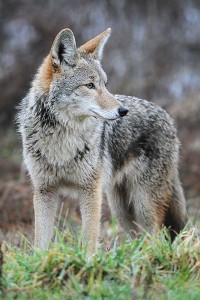ACO uses frequent coyote sightings as ed. opportunity
By Jay TurnerAfter receiving numerous reports of coyote sightings and even a few close encounters throughout the spring and early summer, Canton Animal Control Officer Nadya Branca has noticed a sharp decline in such cases over the past several weeks — a trend, she said, that was not unexpected given the animal’s biological makeup.
In fact, Branca said the phone calls started coming in during the winter and peaked in May, which coincides with the coyotes’ breeding season. During this period, the normally elusive wild canines become more visible — and occasionally more emboldened — as they hunt for themselves and their young.
In the months of May and June, the Animal Control Department received over 30 calls involving coyotes, including at least a few instances where one or more of the animals acted aggressively toward a person or a pet. One resident said she was chased by a coyote, while another resident said a coyote challenged both him and his dog. The Citizen also fielded calls from concerned residents, including one man who described being “stalked” by three coyotes while jogging along Elm and Greenlodge streets in early February.
Branca stressed that no one has reported being bitten or attacked, nor would she expect such an occurrence unless the coyote was sick or injured. Nevertheless, she did reach out to Mass Wildlife, and officials there assured her that “humans are not on the menu.”
“People have a very terrible image of coyotes, but they’re not horrible creatures,” said Branca, who had her own encounter while bike riding in the Blue Hills.
Branca said she learned a wealth of information about the animals from state wildlife officials, and she has been doing her best to pass that knowledge on to residents. For example, many people assume that coyotes travel and hunt in large packs, like wolves; however, family groups typically consist of two to six coyotes, including pups. They are also highly territorial, and a single family often encompasses one or more suburban towns.
At the same time, coyotes did not even appear in Massachusetts until the 1950s, and yet they now occupy every corner of the state with the exception of the islands. Branca said the reason for this expansion is hardly a mystery: Humans inadvertently provide food, which attracts the smaller animals, which in turn attracts the coyotes.
“The problem is that no animal [in Massachusetts] is dominant over the coyote,” she said, “and with so much food available, they take advantage of the resources.”
While coyotes are likely here to stay, Branca said Mass Wildlife suggested that people “take back their neighborhoods” to ensure that they maintain a healthy fear of humans. This includes common-sense measures such as securing one’s pets and garbage and cleaning bird feeders, as well as active resistance if one encounters a coyote — everything from scaring the animal with loud noises to throwing small objects to spraying it in the face with a garden hose.
Branca said most encounters with wildlife are likely to be brief and uneventful, although she stressed that an animal control officer will always be available if people have questions or concerns.
“I always want people to feel like they can call and ask questions and ask for help,” she said. “I don’t want to minimize people’s fear, and I don’t want to take away from anybody’s experience.”
She noted that ACOs do not have the authority to trap and relocate wildlife, but they can intervene if an animal is sick or injured and will “absolutely check it out” if someone calls with a concern.
Branca said she truly enjoys rescuing wildlife and has already encountered quite a few species in her nine months on the job, from swans and snapping turtles to raccoons and muskrats. Other animals known to inhabit the area include foxes, skunks, deer, and fishers. Even black bears are inching their way eastward toward Canton, as evidenced by the recent capture of a bear in Brookline that had also been spotted in Walpole and Dedham.
Branca, for one, is encouraged by the region’s biodiversity and is happy to do her part to educate residents and assist them when necessary.
“I love it,” she said of her job as ACO. “There’s a lot of wildlife out there, and I am hopeful that we can find a way for all of us to live together.”
Short URL: https://www.thecantoncitizen.com/?p=15286











